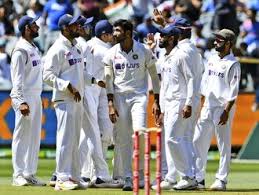Perth: The opening day of the first Test between India and Australia at the Optus Stadium delivered a dramatic spectacle, with bowlers ruling the roost and 17 wickets falling. Both teams struggled to find their footing with the bat, leaving Australia at a precarious 67/7 in response to India’s modest total of 150.

A Battle of Pace and Precision
The match opened with conditions that heavily favored fast bowlers. India, after winning the toss and electing to bat, found themselves in trouble against a disciplined Australian attack led by Josh Hazlewood and Mitchell Starc. The duo extracted significant bounce and pace, dismantling the Indian batting lineup within two sessions.
Yashasvi Jaiswal and Devdutt Padikkal fell for ducks, while Virat Kohli managed just five runs before being dismissed. Amid the carnage, KL Rahul stood out with a composed 26 off 74 balls, reminiscent of his patient innings at Lord’s in 2021. However, India’s hopes rested on a gritty 48-run partnership between Rishabh Pant (37) and debutant Nitish Reddy (41). Their efforts helped India crawl to 150, a total that still felt below par on a challenging but not unplayable pitch.
Bumrah’s Brilliance Turns the Tide
India’s bowlers, led by skipper Jasprit Bumrah, responded with a fiery display. Bumrah’s opening spell was nothing short of spectacular as he claimed three quick wickets, including the prized scalp of Steve Smith for a golden duck. He finished the day with figures of 4/17 in 10 overs, proving why he is considered one of the best bowlers in the world.
Debutant Harshit Rana joined the party, clean bowling Travis Head with a beauty, while Mohammed Siraj removed Mitchell Marsh and the stubborn Marnus Labuschagne (2 off 52 balls). Australia’s batting frailties were exposed, and they ended the day trailing by 83 runs with only Alex Carey (19) and Mitchell Starc (6) holding fort.
Batting Woes on Both Sides
The day was a stark reminder of the declining standards in Test match batting for both teams. While the pitch offered pace and bounce, it wasn’t unplayable. Poor shot selection and an inability to build momentum compounded the struggles.
Historically, encounters between India and Australia were defined by world-class batting duels, but this match has flipped the script, putting bowlers in the spotlight. With the cracks on the pitch expected to widen, batting in the second innings could become even more challenging.
What Lies Ahead
Australia’s lowest-ever score in Perth is 76, recorded against the West Indies in 1984, and such a collapse cannot be ruled out. For India, an early breakthrough on Day 2 could put them firmly in control. However, with batting proving to be a struggle, any lead will be invaluable.
Starc, speaking after the day’s play, admitted that the wicket was unlikely to improve, making the coming sessions crucial. If India’s bowlers continue their disciplined approach, they could capitalize on the momentum and push Australia into a corner.
As the Perth Test unfolds, the match has already shown signs of being a modern-day classic—a battle where bowlers dictate terms and every run becomes a prized possession.


